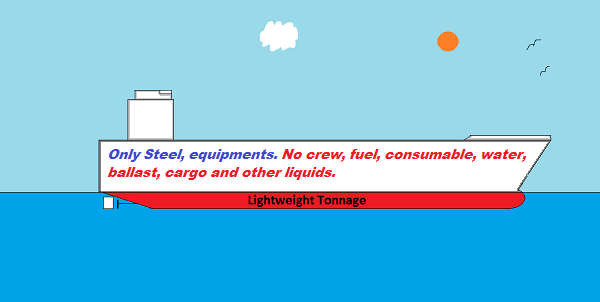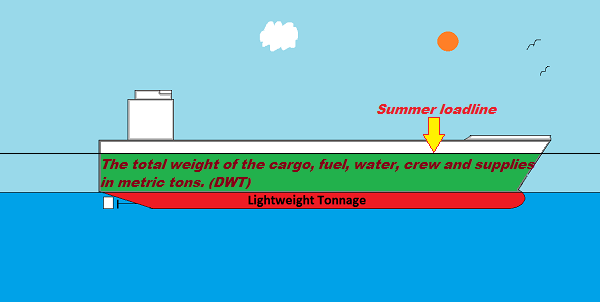Everyone who has looked at specifications for ships is often bewildered by the many different tonnages used for the same ship as DWT, GT, NT, LWT ect.,
Visit: Shipbuilding Knowledge A-Z for more free topics on shipbuilding
An ocean ship may have different gross tonnage, depending on which country’s rules were used in determining the weight.
Below is a good explanation on just what the tonnages for ships really are.
TONNAGE (DWT, Displacement, Lightweight)
Lightweight (LWT, LDT or LWDT)

Basically the weight of the ship itself with no cargo, stores etc.
Used widely at the time vessels are negotiating for scrap
Otherwise of little use as weight of steel is no indication of vessel size with similar sizes having huge tonnage variation due to type of steel used.
Deadweight (DWT)

Maximum vessel can carry in tonnes by way of cargo, stores, fuel, crew etc which is not permanent part of structure of ship up to the maximum summer load line.
Reasonable measurement for majority liquid or dry bulk vessels as cargo component forming close to 98% of DWT
Unrepresentative for majority of vessels carrying low density cargoes like containers, LNG, passengers, vehicles etc
Displacement

Basically the full weight of a fully laden ship
DISPLACEMENT = DWT plus LWT
CAPACITIES (Liquid (m3), Liquid Gas (m3), Grain (m3), Ore (m3), Bale (m3), TEUs, Lane Metres (m), Cars, Trucks, Trailers, Passengers etc)
Cubic Capacity (m3)
Liquid, Liquefied Gas, Grain, Ore, Bale
Units
Lane Metres – Linear (cannot convert to m3)
No of passengers (cannot convert to m3)
No of vehicles (cannot convert to m3)
TEU-Twenty-foot equivalent unit (CAN convert to m3!)
HYBRIDS (GRT/GT, NRT/NT, SCNT, PCNT, CGT)
Gross Tonnage (GT) – superseded (GRT)
An artificial ‘tonnage’ measurement based on the total volume of enclosed spaces
Calculated by taking the total capacity of enclosed spaces in m3 (V) and multiplying by a coefficient (K) calculated by 0.2+0.02 log10V (e.g. 100,000 m3 x 0.3 becomes 30,000 GT and 200,000 m3 x 0.306 becomes 61,200 GT)
Better than DWT for comparing vessels with low density cargoes within enclosed spaces with high density cargoes
BUT useless for container ships with majority of cargo outside enclosed spaces
AND Complicated, Meaningless, Unrepresentative

Net Tonnage (NT) – superseded (NRT)
An artificial ‘tonnage’ measurement based on the total volume of enclosed spaces dedicated to cargo (below main deck)
Calculated by formula:
NT = K2 Vc (4d/3D)2 + K3 (N1 + (N2 / 10))
K2 = as per K in GT, Vc = m3 enclosed cargo space d = moulded draught amidships, D = moulded depth amidships, N1 = no passengers with not more than 8 berths N2 = no of other passengers K3 = 1.25 ((GT+10,000)/10,000)
A ‘Black Art’
Even worse than GT!!
Too Complicated to be calculated by Shipyards


2 thoughts on “SHIP TONNAGE AND HYBRID MEASUREMENT”